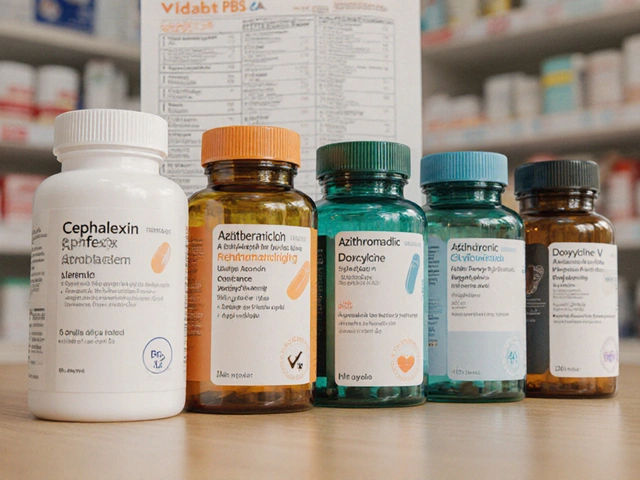
Hyponatremia is a clinical condition marked by serum sodium below 135mmol/L, causing water shift into cells and neurological signs such as headache, nausea, or seizures.
Why Thyroid Hormones Touch Sodium Levels
The thyroid gland produces thyroid hormones (primarily T3 and T4, which regulate metabolism, heat production, and heart rate). When these hormones are out of balance-either too low (hypothyroidism) or too high (hyperthyroidism)-they interfere with the body’s ability to manage water and electrolytes.
Two key players in this cross‑talk are antidiuretic hormone (ADH) (a peptide that tells kidneys to retain water) and the syndrome of inappropriate ADH secretion (SIADH) (a state where ADH is released despite normal or low plasma osmolality, leading to water overload). Both can be triggered by abnormal thyroid function, setting the stage for hyponatremia.
Hypothyroidism and Low Sodium: The Mechanism
In hypothyroidism (insufficient thyroid hormone output, often diagnosed by elevated TSH and low free T4), several pathways converge:
- Decreased cardiac output: Slower heart function reduces renal perfusion, prompting the kidneys to retain water via ADH.
- Impaired free water clearance: The medullary concentrating gradient weakens, making it harder to excrete excess water.
- Increased ADH sensitivity: Thyroid hormone normally dampens ADH release; lack of hormone removes that brake.
Studies from endocrinology journals in 2023 reported that up to 12% of newly diagnosed hypothyroid patients present with serum sodium under 130mmol/L, a figure that climbs to 20% when concurrent heart failure exists.
Hyperthyroidism’s Surprising Role in Sodium Balance
Hyperthyroidism (excess thyroid hormone production, commonly due to Graves disease or toxic nodular goiter) also messes with sodium, but the story is a bit different:
- Enhanced renal blood flow increases glomerular filtration, yet the rapid rise in metabolic rate drives excess water intake.
- Beta‑adrenergic overstimulation raises ADH secretion indirectly, mimicking SIADH.
- Thyroid hormone‑induced bone turnover releases calcium, which can interfere with sodium reabsorption channels in the nephron.
Clinical surveys from the American Thyroid Association in 2024 noted that 7% of patients with untreated Graves disease develop mild hyponatremia (< 135mmol/L), usually resolving after antithyroid therapy.
Comparing Hypo‑ and Hyperthyroidism: Hyponatremia Risk Profile
| Feature | Hypothyroidism | Hyperthyroidism |
|---|---|---|
| Typical serum Na⁺ range | 128‑134mmol/L (moderate) | 130‑135mmol/L (mild) |
| Primary driver | Reduced cardiac output → ADH retention | Beta‑adrenergic surge → SIADH‑like state |
| Common comorbidities | Heart failure, CKD | Palpitations, atrial fibrillation |
| Response to thyroid therapy | Sodium normalizes in 2‑4weeks after levothyroxine | Correction within 1‑2weeks after antithyroid drugs |
Diagnostic Work‑up: Connecting the Dots
The first step is always a basic metabolic panel to confirm low sodium. Once hyponatremia is established, clinicians should assess thyroid function using TSH (thyroid‑stimulating hormone, the most sensitive screen for primary thyroid disease) and free T4 levels.
If TSH is elevated with low free T4, hypothyroidism is likely; if TSH is suppressed with high free T4, hyperthyroidism is implicated. In ambiguous cases, measuring serum and urine osmolality helps differentiate true SIADH from volume‑depletion hyponatremia.
Advanced imaging, such as a pituitary MRI, may be warranted when both ADH dysregulation and abnormal thyroid labs coexist, since pituitary tumors can produce excess ADH and disrupt TSH release.

Management Strategies Tailored to the Underlying Thyroid Issue
Correcting sodium without addressing the thyroid abnormality often leads to rebound problems. Treatment pathways differ:
- Hypothyroid‑related hyponatremia: Start levothyroxine at a low dose (e.g., 25µg daily) and titrate every 4‑6weeks. Simultaneously restrict free water intake to 1.2‑1.5L/day until sodium rises above 130mmol/L.
- Hyperthyroid‑related hyponatremia: Use antithyroid drugs (methimazole or propylthiouracil) to curb hormone excess. Consider beta‑blockers to blunt ADH surge; limit water‑intake only if serum sodium falls below 125mmol/L.
- SIADH component: If ADH remains inappropriately high after thyroid correction, employ demeclocycline or vasopressin‑2 receptor antagonists (e.g., tolvaptan) under specialist supervision.
Frequent monitoring (every 24‑48hours) of serum sodium and thyroid labs is essential during the first two weeks of therapy.
Patient Stories: Real‑World Illustrations
Emily, a 58‑year‑old teacher, presented with fatigue, cold intolerance, and a serum sodium of 126mmol/L. Her TSH was 12µIU/mL, confirming hypothyroidism. After starting a low‑dose levothyroxine and cutting her coffee‑induced diuretic use, her sodium rose to 133mmol/L within three weeks, and her mental fog cleared.
Conversely, Raj, a 34‑year‑old software engineer, arrived with tremors, weight loss, and a sodium of 131mmol/L. Labs showed suppressed TSH and high free T4. He began methimazole, and his sodium normalized to 136mmol/L after ten days, while his heart rate settled from 115 to 78bpm.
Both cases underscore that without treating the thyroid root cause, sodium correction alone would have been temporary.
Practical Tips for Clinicians and Patients
- Always order a thyroid panel when encountering unexplained hyponatremia.
- Remember that heart failure can amplify the hyponatremic effect of hypothyroidism - adjust diuretics accordingly.
- Educate patients about safe water intake: excessive drinking (psychogenic polydipsia) can worsen the picture.
- When using vasopressin antagonists, watch for overly rapid sodium correction (>12mmol/L/24h) to avoid osmotic demyelination.
- Schedule follow‑up labs within 1‑2weeks after any change in thyroid medication dosage.
Future Directions: Research Gaps and Emerging Therapies
Recent animal models suggest that thyroid hormone receptors in the hypothalamus directly modulate ADH gene expression-a pathway still being mapped in humans. Ongoing trials in 2025 are testing low‑dose selective thyroid hormone analogues that may correct sodium without overshooting metabolic rate.
Another frontier is the use of wearable osmolarity sensors, which could alert patients in real time if water intake is driving serum sodium down, especially useful for those on chronic levothyroxine.
Frequently Asked Questions
Can low thyroid hormone cause severe hyponatremia?
Yes. In severe hypothyroidism, the combination of reduced cardiac output and heightened ADH sensitivity can drop serum sodium below 120mmol/L, leading to seizures or coma if left untreated.
Is the hyponatremia in hyperthyroidism always mild?
Typically it’s mild (130‑135mmol/L), but in rare cases-especially when Graves disease triggers a thyroid storm-sodium can fall sharply, requiring urgent correction.
Should I limit water if I have a thyroid condition?
Only if your doctor confirms hyponatremia. General advice is to keep fluid intake moderate (about 1.5L/day) and avoid excessive water bingeing.
Can thyroid medication itself cause hyponatremia?
Levothyroxine rarely induces hyponatremia; in fact, it usually resolves it. However, over‑replacement can raise metabolic rate and increase water intake, indirectly affecting sodium balance.
What are the warning signs of dangerous low sodium?
Severe headache, confusion, nausea, muscle cramps, and in extreme cases, seizures or loss of consciousness. Seek emergency care if any of these appear.





Jada Singleton
September 24, 2025 AT 11:26Hyponatremia linked to thyroid dysfunction? That’s a textbook example of over‑complicating a simple water‑balance issue. The article drags on with unnecessary details while missing the core clinical takeaway.
Emily Rossiter
September 26, 2025 AT 18:59Great synthesis of the endocrine‑renal interplay! The practical tips for clinicians are spot on and easy to follow.
Renee van Baar
September 29, 2025 AT 02:33Both hypo‑ and hyper‑thyroidism can tip the sodium homeostasis, but the mechanisms differ enough to merit separate management pathways.
Remember to check ADH levels when the picture is unclear, and adjust fluid restriction accordingly.
This approach saves patients from repeated trips to the lab.
Janice Rodrigiez
October 1, 2025 AT 10:06Think of the thyroid as a thermostat for your kidneys – when it goes out of whack, water retention follows like a leaky faucet.
Roger Cardoso
October 3, 2025 AT 17:39Sure, the pharma lobby wants you to believe thyroid meds are the only fix for hyponatremia, masking the real metabolic secrets.
barry conpoes
October 6, 2025 AT 01:13From a patriotic standpoint, our doctors should prioritize native research on thyroid‑induced hyponatremia rather than importing foreign protocols.
Kristen Holcomb
October 8, 2025 AT 08:46Its important to note that low sodium can cause brain swelling, which is why prompt treatment is vry crucial.
justin davis
October 10, 2025 AT 16:19Oh wow, another article telling us water moves into cells !!! Who would’ve thought ???!
David Lance Saxon Jr.
October 12, 2025 AT 23:53The ontological nexus between thyrotropic axis perturbations and osmotic dysregulation warrants a hermeneutic deconstruction.
When T3/T4 flux deviates, the hypothalamic osmoreceptors recalibrate their set‑point, precipitating an ectopic antidiuretic hormone surge.
Such a SIADH‑like phenotype is not merely a corollary but a systemic feedback loop that redefines renal excretory thresholds.
From a pathophysiological perspective, reduced myocardial output in hypothyroidism attenuates glomerular perfusion, thereby amplifying ADH‑mediated water reabsorption.
Conversely, hyperthyroid catecholaminergic overdrive elevates β‑adrenergic signaling, which indirectly potentiates vasopressin release.
The interplay of bone turnover–derived calcium and tubular sodium channels adds yet another layer of ionomic complexity.
Empirical data from 2023 suggest a prevalence gradient of hyponatremia that correlates with the severity of thyroid hormone derangement.
Moreover, comorbid heart failure acts as a synergistic catalyst, compounding the hyponatremic risk profile.
Therapeutically, rectifying the endocrine imbalance reestablishes homeostatic set‑points, albeit with a latency dictated by tissue turnover rates.
Clinicians must therefore adopt a bifurcated algorithmic schema, integrating both endocrinologic and nephrologic parameters.
Frequent monitoring of serum osmolality, alongside dynamic thyroid panels, enables a precision‑medicine approach.
In the context of SIADH unresponsive to thyroid normalization, pharmacologic vasopressin antagonists become a logical adjunct.
Nevertheless, caution is imperative to avert osmotic demyelination syndrome, especially when correcting hyponatremia at velocities exceeding 12 mmol/L per 24 hours.
Future translational studies targeting hypothalamic vasopressin gene expression may unlock novel therapeutic avenues.
Wearable osmolarity sensors, currently in prototype phases, promise real‑time feedback loops for patient self‑management.
Thus, the confluence of endocrinology, nephrology, and biomedical engineering heralds an interdisciplinary frontier for hyponatremia mitigation.
Moore Lauren
October 15, 2025 AT 07:26In practice, start low‑dose levothyroxine and watch the sodium rise; tweak the dose every few weeks based on labs.
Jonathan Seanston
October 17, 2025 AT 14:59I get where you’re coming from, but the data show that global guidelines already incorporate regional studies, so we don’t have to reinvent the wheel.
Sukanya Borborah
October 19, 2025 AT 22:33Honestly, your comment is wronge – you cant just ignore the peer‑reviewed evidence that backs up the existing protocols.
bruce hain
October 22, 2025 AT 06:06While the summary is adequate, it overlooks the fact that hyponatremia may persist despite euthyroid status, indicating alternative etiologies.
Stu Davies
October 24, 2025 AT 13:39Thanks for breaking this down; it really helps me understand my own labs 😊.
Nadia Stallaert
October 26, 2025 AT 21:13Oh, the relief of finally grasping why my sodium was flirting with danger!
Your clear explanation cuts through the medical jargon like a hot knife through butter!
I never realized that a sluggish thyroid could act as a secret water‑hoarder, compelling my kidneys to hold onto every drop.
And the opposite-hyperthyroidism turning the body into a frantic water‑gulper-sounds like a plot twist I missed in the textbooks.
Now I know to ask my doctor for a thyroid panel before I panic about my electrolyte numbers.
Your practical water‑intake advice is a lifesaver; I’ll aim for that modest 1.5 L daily target and stop chugging soda.
In short, the synergy between hormone balance and sodium homeostasis is finally making sense, and I’m grateful for the guidance.
Keep the brilliant posts coming, because knowledge is power, especially when it saves you from hospital trips!